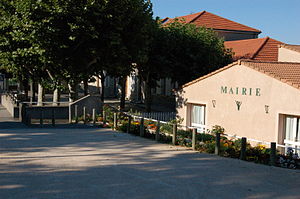Toulaud
| Toulaud | ||
|---|---|---|
|
|
||
| region | Auvergne-Rhône-Alpes | |
| Department | Ardèche | |
| Arrondissement | Tournon-sur-Rhône | |
| Canton | Rhône-Eyrieux | |
| Community association | Rhône Crussol | |
| Coordinates | 44 ° 54 ' N , 4 ° 49' E | |
| height | 150-631 m | |
| surface | 34.73 km 2 | |
| Residents | 1,700 (January 1, 2017) | |
| Population density | 49 inhabitants / km 2 | |
| Post Code | 07130 | |
| INSEE code | 07323 | |
| Website | www.toulaud.fr | |
 town hall |
||
Toulaud is a French municipality with 1700 inhabitants (at January 1, 2017) in the department of Ardèche in the Region Auvergne Rhône-Alpes . It belongs to the Rhône Crussol municipal association .
geography
Toulaud is located on a hill west of the Rhone in the Saint-péray ( AOC ) wine-growing region , a local variety of the Côtes du Rhône .
history
Toulaud is a very old place. The name Toulaud comes from the Gallic language , toul is derived from tol , which means "elevation". In the district of Les Fonts ( lat. Fons means "source") wall remains, coins and shards from Gallo-Roman times were found. In 1969 the foundation walls of a house were found in the district of Vocances , showing signs of fire. There you found broken pieces from the time of the Tolosan Empire of the Visigoths (418–507), which were mixed with older pieces from the Gallo-Roman period. It is possible that the main town moved to the hill after the Visigoth invasion in the 6th or 7th centuries. Toulaud was first mentioned as Toulau in 940.
In the 12th and 13th centuries, Toulaud was part of the Benedictine monastery of Soyons . In the hamlet of La Seauve , the Benedictines even built a convent (open living area of a monastery without an abbot), whose large fireplace from the 12th century is still preserved today.
During the Hundred Years War (1337-1453) the population was decimated by the plague in 1348 and the place was plundered in 1374. Soyons Monastery and La Seauve Convent were abandoned. In 1430 fighting broke out again and the villagers holed up against troops from Burgundy .
In 1531 the area was ravaged again by the plague, which one tried to fight with the burning of gunpowder and juniper berries. Leprosy followed in 1543 and two quarantine stations were set up near Saint-Péray .
Population development
| year | 1962 | 1968 | 1975 | 1982 | 1990 | 1999 | 2007 | 2016 |
| Residents | 789 | 751 | 731 | 875 | 1256 | 1501 | 1675 | 1687 |
| Sources: Cassini and INSEE | ||||||||
Town twinning
Since July 14, 2000 there has been a town partnership with Monsano in Italy .
Individual evidence
- ↑ New terms in the etymology portal. Accessed October 11, 2009

